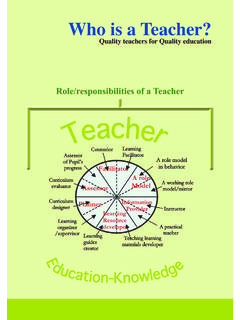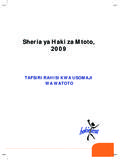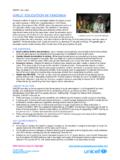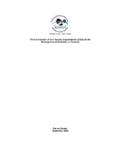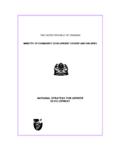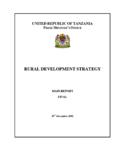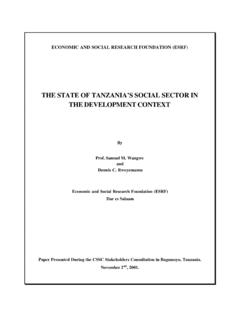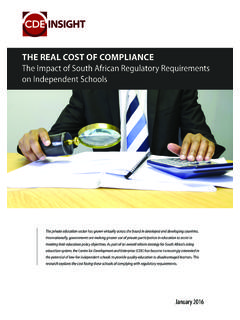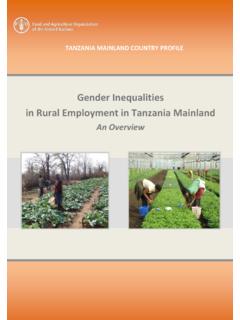Transcription of Secondary Education in Tanzania: Key Policy …
1 Working paper 06. 4. Secondary Education in tanzania : Key Policy Challenges Suleman Sumra & Rakesh Rajani Secondary Education in tanzania : Key Policy Challenges1. Suleman Sumra & Rakesh Rajani2. 1. Introduction Since 2002, tanzania has seen an ambitious set of Policy reforms in primary and more recently in Secondary Education . These have dramatically improved the state of Education in the country, particularly in terms of classroom infrastructure and enrolment. Some of the key achievements are highlighted in the next section, Background'. We could take more time to explain these successes, but perhaps HakiElimu was not invited to this meeting to elaborate on these!
2 The topic we were given are the major Policy challenges in Secondary Education in tanzania . This is consistent with our general approach, where we acknowledge progress made, but then move on to focus on the challenges, so as to make a good thing even better. We are confident that the Government and its partners also prefer spending valuable time on what still needs to be done, and how to do it best. This essay presents five Policy challenges in basic Education . In most cases primary and Secondary Education are treated together, because they are inextricably linked in so many ways, and because success at the Secondary level is fundamentally dependent on getting the basics right at the primary level.
3 In assessing the five Policy challenges, we are guided by the following three simple questions regarding Secondary Education : Are our goals clear, consistent and are they the most important? Will the goals lead to the results we seek? Given resource constraints, are our priorities the most strategic? All the challenges are linked to a central Policy question, which is clarity about the goals and purposes of Education , or about defining the meaning of an educated person. We briefly outline the conceptual and Policy issues, and make specific recommendations in each case. 2. Background Since 2001, tanzania has taken major strides to revamp its primary and Secondary Education sectors.
4 The Primary Education Development Plan (PEDP, 2002-2006) and the Secondary Education Development Plan (SEDP) implemented starting in 2004 have led to significant improvements in provision of basic Education in the country. Primary school enrolment The most impressive achievement has been expanded enrolments. Enrolment in primary Education increased from 4,839,361 in 2001 to 7,959,884 in 2006. The Net Enrolment Ratio 1 A version of this essay was first presented at Presentation for the Launch Seminar of The Norwegian Post-Primary Education Fund for Africa (NPEF), Oslo, September 13 14, 2006 co-organized by the Norwegian Government and the World Bank as a response to keynote remarks made by the tanzania Minister for Education and Vocational Training Margaret Sitta.
5 2 Suleman Sumra is a retired professor of Education and an independent researcher who can be reached at Rakesh Rajani is the executive director of HakiElimu. 1. (NER) in primary schools increased from in 2001 to in 2006. This means that nearly all the children of primary school age are now enrolled in primary schools. Secondary school enrolment Increased primary enrolments create increased pressure further up the pipeline at the Secondary level. Expansion of Secondary enrolment has been equally impressive, though far from reaching the levels attained in primary Education . Enrolment in Form 1, the first year of Secondary Education , increased from 99,744 in 2003 to 243,359 in 2006.
6 GER has increased from in 2003 to in 2006. Secondary NER is reported to have doubled from in 2003 to in 2006. Infrastructure Increases in enrolments are matched by improvements in school infrastructure. New classrooms have been built and new schools constructed. Primary schools across the country are characterized by new classrooms. More than a thousand new government Secondary schools were built between 2003 and 2006; and the number of Secondary schools has increased from 1,083 in 2003 to 2,289 in 2006, largely through the establishment of new government Secondary schools (whereas prior to SEDP much of the increase in recent years was led by private Secondary schools).
7 Toilets (pit latrines) and teachers' houses have also been constructed in large numbers too, though at a lower pace as compared to new classrooms. Books and teachers In recent years the provision of books to the school level has increased dramatically, primarily through the capitation grant'. The pupil: book ratios have improved, though are yet to reach adequate levels, possibly because the full capitation grant has not reached the school level on time. The supply of teachers has also gone up, with over 32,000 new teachers recruited in the first three years of PEDP alone. However, the increase in pupils has outstripped the recruitment of teachers.
8 Albeit belatedly, greater attention and resources are given to recruiting teachers for Secondary , who need to be better equipped than primary school teachers. In August 2006. President Kikwete announced that all university BA students in Education will get a full scholarship in a move to spur the supply of competent teachers. In sum, tanzania has experienced tremendous progress in Education in the last five years. After decades of neglect, these efforts were sorely needed. The Government's political commitment has been exemplary from President Mkapa's second term in office to the steadfast resolve in the current government exhibited by President Kikwete, Prime Minister Lowassa and Minister Sitta.
9 The rhetoric has also been backed up by resources, as the budget for basic Education has increased significantly in each year of this period. There is a clear sense that things are moving, and a feeling of excitement and optimism. For all of this, the Government and its partners (including the Government of Norway and the World Bank) deserve commendation. But this does not mean that the future is going to be any less challenging. As the numbers in primary Education swell and the momentum to expand Secondary Education gathers steam, even greater strategic Policy clarity will be needed to guide prioritization, resource allocation and implementation.
10 We suggest the following five challenges are the most critical today. 3. Five Policy Challenges Policy challenge one: Establish clear targets Unlike in primary Education , it is difficult to ascertain the actual targets and timeframes for Secondary Education in tanzania . The SEDP document has two sets of targets the maximum 2. growth' scenario endorsed in official government documents with a target of 50% NER by 2009. and a significantly different medium growth' scenario endorsed by the World Bank agreement with the Government. Despite several attempts, we were unable to establish which the agreed target was, possibly because there is no such thing.
